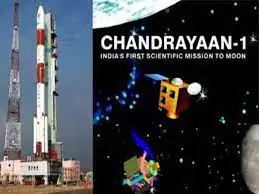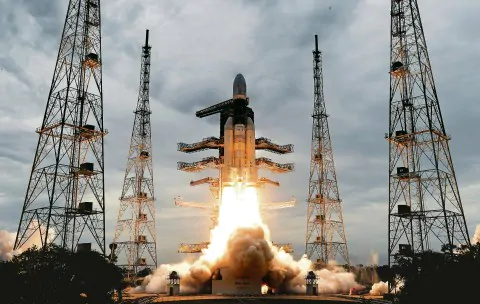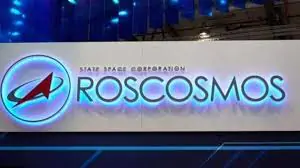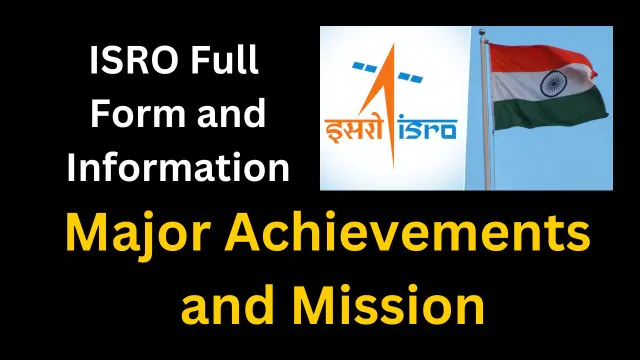Introduction :
In the vast expanse of the universe, humanity’s thirst for knowledge and exploration knows no bounds. One organization that has been at the forefront of this cosmic journey is ISRO, which stands for Indian Space Research Organization. ISRO has played a significant role in shaping India’s presence in the global space arena and has contributed significantly to our understanding of space science and technology. In this comprehensive guide, we will cover the full profile, history, achievements and future prospects of ISRO while highlighting its remarkable journey in the field of space exploration.
Chapter 1 : ISRO Full Form and Origin
ISRO, the short form of Indian Space Research Organisation, was established on August 15, 1969. Its primary objective is to harness space technology for national development by advancing space science research and planetary exploration. ISRO, headquartered in Bengaluru, India, is a symbol of excellence and innovation in the global space community.
Chapter 2: Historical Milestones
ISRO’s journey began with humble but firm steps. It launched its first satellite, Aryabhata, in 1975, marking India’s entry into the space race. Over the years, ISRO achieved several milestones, including the successful launch of the Chandrayaan-1 mission to the Moon in 2008, the Mars Orbiter Mission (Mangalyaan) in 2013 and the launch of a record 104 satellites in a single mission in 2017. These achievements have established ISRO among the elite space agencies globally.
Chapter 3: Major Achievements and Mission
ISRO’s success can be attributed to its ambitious missions and phenomenal achievements. Some notable missions and achievements include:
Chandrayaan Missions:
Chandrayaan is India’s lunar exploration programme, consisting of a sequence of missions operated by the Indian Space Research Organization (ISRO). The program began in 2008 with the launch of Chandrayaan-1, India’s first lunar mission. Since then, two more missions have been launched: Chandrayaan-2 in 2019 and Chandrayaan-3 in 2023.
Chandrayaan-1
Launched on October 22, 2008 from the Satish Dhawan Space Center in Sriharikota, India, Chandrayaan-1 consisted of an orbiter, an impactor, and a Moon Mineralogy Mapper (M3). The primary spacecraft, the orbiter, was designed to orbit the Moon at an altitude of 100 kilometers. The impactor, named Moon Impact Probe (MIP), was intended to hit the Moon’s surface at a velocity of 1.4 kilometers per second. M3 was tasked with mapping the chemical composition of the Moon’s surface.

Chandrayaan-1 proved to be a successful mission. The orbiter performed more than 3,400 lunar orbits, and mapped more than 95% of the lunar surface. MIP successfully impacted the Moon and data from M3 revealed the past presence of water on the Moon.
Chandrayaan-2
Chandrayaan-2, launched from the Satish Dhawan Space Center on July 22, 2019, consisted of an orbiter, a lander and a rover. The mission of the orbiter was to maintain an orbit around the Moon at an altitude of 100 kilometers. The lander named Vikram was intended to make a soft landing on the lunar surface and deploy a rover named Pragyan.

Chandrayaan-2 got partial success. The orbiter successfully entered lunar orbit, but the lander suffered a technical failure and crashed on the lunar surface, preventing deployment of the rover.
Chandrayaan-3
Chandrayaan-3, launched from the Satish Dhawan Space Center on July 14, 2023, consisted of a lander and a rover. Lander Vikram successfully landed on the lunar surface on August 23, 2023. Subsequently, the rover, Pragyan, was successfully deployed and exploration of the lunar terrain was initiated.

Chandrayaan-3 marked a successful mission, cementing India’s position as the fourth country to successfully land a spacecraft on the Moon. The lander and rover collected valuable data about the lunar surface, including the identification of water ice.
Summary
The Chandrayaan mission has emerged as a significant achievement for ISRO, providing invaluable insights into the chemical composition, mineralogy and geology of the Moon. These missions have also demonstrated India’s growing strength in the field of space exploration.
Mars Orbiter Mission (Mangalyaan):
Mars Orbiter Mission (MOM), also known as Mangalyaan, marked India’s inaugural attempt in interplanetary exploration. Launched on 5 November 2013 under the aegis of the Indian Space Research Organization (ISRO), it successfully achieved Mars orbit on 24 September 2014.
The primary objective of the mission was to demonstrate India’s prowess in interplanetary space exploration, thereby providing evidence of its technological capabilities. Additionally, it serves a number of scientific purposes, including:
- To investigate the atmosphere and climate of Mars.
- To investigate the features of the surface of Mars.
- To find evidence of past or present existence of water on Mars.
The 1350 kg MOM spacecraft was equipped with five scientific instruments:
- A Mars Color Camera (MCC) for imaging the surface of Mars.
- A Mars Exospheric Neutral Composition Analyzer (MENCA) to analyze the composition of the Martian atmosphere.
- A Thermal Infrared Imaging Spectrometer (TIS) to probe the temperature and composition of the surface of Mars.
- A magnetometer (MAG) to probe the magnetic field of Mars.
- A Dust Particle Sensor (DPS) to study dust particles in the Martian atmosphere.
MOM mission is a remarkable achievement for ISRO. Notably, it represents the first interplanetary attempt by an Asian nation and marks the first successful Mars mission on the first attempt. The mission yielded a wealth of scientific data regarding Mars, a treasure still under investigation by scientists.
The MOM mission, scheduled to end on September 24, 2022, was eventually terminated due to the depletion of its fuel reserves, after having accomplished its primary objectives and extending its mission lifetime by several years.
The mission was a pivotal moment in India’s space programme, serving as a source of inspiration for a new generation of scientists and engineers. It also underlines the growing capabilities of India’s space programme, placing it among the world’s leading space exploration efforts.
Here are some of the key scientific findings from the MOM mission:
- The atmosphere of Mars is extremely thin and dry.
- Evidence suggests the past presence of water on Mars, although it is now largely locked within the polar ice caps.
- The surface of Mars is marked by a landscape dotted with craters and volcanoes.
- Currently, there are no obvious signs of life on Mars.
The MOM mission has paved the way for upcoming Indian missions to Mars. ISRO is currently preparing a second Mars mission for launch in 2024. The mission aspires to greater ambition, including both a lander and a rover to the surface of Mars.
Navigation and Communication Satellites:
Indian Space Research Organization (ISRO) has successfully developed two satellite navigation systems:
- Indian Regional Navigation Satellite System (IRNSS), also known as NavIC (Navigation with Indian Constellation). It is a regional satellite navigation system designed to provide accurate positioning services to users in an area extending up to 1,500 kilometers from India and its borders. IRNSS consists of seven geosynchronous satellites.
- GPS Aided Geo Augmented Navigation (GAGAN), a Satellite Based Augmentation System (SBAS). GAGAN enhances the accuracy and reliability of GPS signals, especially for civil aviation applications in India. The system is constituted by two geostationary satellites, namely GSAT-8 and GSAT-10.
Additionally, ISRO operates a number of communication satellites that carry out various services including telecommunications, television broadcasting, weather forecasting and disaster alerts. Some of the notable communication satellites managed by ISRO are:
- INSAT Series: The INSAT series forms the most comprehensive domestic communication satellite network in the Asia-Pacific region, consisting of more than 20 geosynchronous satellites.
GSAT Series: The GSAT series represents a new generation of communication satellites developed by ISRO. These satellites are equipped with advanced features and capabilities including high-throughput communication, weather forecasting and disaster alerts.
ISRO’s satellite development spans a wide range of categories, including navigation, communications, earth observation and scientific satellites. These satellites play a vital role in furthering India’s space program and providing diverse services to the country and the global community.
The use of ISRO’s navigation and communication satellites offers several benefits:
- Precision: ISRO’s navigation satellites provide highly accurate position information required for applications such as navigation, survey and disaster management.
- Reliability: These satellites are known for their reliability and extended lifetime, ensuring uninterrupted service provision to the users.
Cost-effectiveness: ISRO’s navigation satellites are a cost-effective option compared to other navigation satellite systems, making them a practical option for users in developing countries.
ISRO’s navigation and communication satellites are playing an increasingly important role in the progress of India and the global community. They make significant contributions by providing accurate position data, reliable communication services and advanced weather forecasting capabilities, thereby enhancing the quality of life of people in various ways.
Astrosat:
AstroSat is India’s first dedicated multi-wavelength space telescope. It was launched on PSLV-XL on September 28, 2015. AstroSat carries a total of five scientific payloads that enable imaging, studying the temporal and spectral properties of Galactic and extra-Galactic cosmic sources across a wide range of wavelengths on a common platform.
AstroSat has five payloads:
- The Large Area X-ray Spectrometer (LAXPC) is a wide-field X-ray spectrometer that can image and study the spectra of X-ray sources.
- The Soft X-ray Telescope (SXT) is a high-resolution X-ray telescope that can image and study the spectra of soft X-ray sources.
- The Ultraviolet Imaging Telescope (UVIT) is a dual-channel ultraviolet telescope that can image and study the spectra of ultraviolet sources.
- The Cadmium Zinc Telluride Imager (CZTI) is a gamma-ray imager that can image and study the spectra of gamma-ray sources.
- The Indian X-ray Monitor (IXRM) is a monitoring device that can provide continuous monitoring of X-ray sources.
- AstroSat has been used to study a variety of astronomical objects, including black holes, neutron stars, galaxies, and quasars. It has also been used to study the evolution of stars and the formation of galaxies.
AstroSat is still operational and is expected to provide specific science data for the next several years. It will continue to serve the astronomy community even after it meets its end as archival data.
Here are some of the key findings of AstroSat:
Discovery of a new class of black holes called ultraluminous X-ray sources.
Detection of gravitational waves from the merger of two neutron stars.
The study of the life cycle of stars from their birth to their death.
Discovery of the early universe and the formation of galaxies.
Astrosat is a major milestone in India’s space program and has made significant contributions to astronomy. It is a valuable asset to the global astronomy community and will continue to provide important insights into the universe for many years to come.
Chapter 4: ISRO’s Global Collaborations
The Indian Space Research Organization (ISRO) has a long history of international cooperation. Some of its major partnerships include:
NASA: ISRO has collaborated with NASA on several missions, including the Chandrayaan-1 mission to the Moon, the Mars Orbiter mission and the upcoming NISAR mission.

European Space Agency (ESA): ISRO has collaborated with ESA on AstroSat mission to study X-rays from celestial objects and ExoMars mission to search for life on Mars.

French Space Agency (CNES): ISRO has collaborated with CNES on the Megha-Tropiques mission to study the tropical environment and the SARAL mission to study the Indian Ocean.

Russian Space Agency (Roscosmos): ISRO has collaborated with Roscosmos on the GSAT-6A satellite, which provides communications services to India.

Japan Aerospace Exploration Agency (JAXA): ISRO has collaborated with JAXA on the Aditya-L1 mission and the joint lunar mission LUNAR-2 to study the Sun.

Apart from these major partnerships, ISRO has also collaborated with space agencies of other countries, such as the Canadian Space Agency, the German Aerospace Center and the South Korean Aerospace Research Institute.
These collaborations have helped ISRO achieve its goals of space exploration, scientific research and national development. He has also helped promote international cooperation in space exploration.
Some of the benefits of ISRO’s global collaboration are:
- Access to new technologies and expertise: Collaboration with other space agencies can provide ISRO access to new technologies and expertise that it would not otherwise have. This can help ISRO develop more advanced and capable space systems.
- Sharing resources: Collaboration can also help ISRO share resources with other space agencies. This can save costs and make developing and launching space missions more efficient.
- Enhancement of knowledge and understanding: Collaboration can help ISRO gain better understanding of space science and technology.
- Enhanced International Cooperation: Collaboration can help promote international cooperation in space exploration. This could be beneficial for all countries involved, as it could help reduce costs and risks and increase the chances of success.
- ISRO is committed to continuing its global collaboration in space. These collaborations will help ISRO achieve its goals of space exploration, scientific research and national development. They will also help promote international cooperation in space exploration.
Chapter 5: Challenges and Future Prospects
The Indian Space Research Organization (ISRO) has made significant progress in recent years and has become one of the leading space agencies in the world.
- Limited budget: ISRO’s budget is relatively small as compared to other major space agencies like NASA and European Space Agency. This limits its ability to launch more missions and develop new technology.
- Brain drain: India produces some of the world’s best scientists and engineers, but many of them are gobbled up by foreign companies. This brain drain could hinder ISRO’s ability to attract and retain top talent.
- Lack of infrastructure: ISRO does not have a dedicated launch pad for heavy-lift rockets. This means it will have to rely on overseas launch facilities, which can be costly and time-consuming.
- International Competition: The space industry is becoming increasingly competitive, with countries such as China and Japan making large investments in space exploration. ISRO needs to find ways to stay ahead to maintain its leadership position.
- Despite these challenges, ISRO’s future is bright. The Indian government is committed to increasing ISRO’s budget, and the agency is working to attract and retain top talent. ISRO is also developing new technologies such as reusable launch vehicles, which will give it a competitive edge in the global space market.
Some of the future possibilities of ISRO are as follows:
- Manned Mission to Mars: ISRO is planning to send a manned mission to Mars by 2030. This will be a major milestone for the agency and will showcase India’s technological prowess.
- Development of Small Satellite Launch Vehicles: ISRO is developing Small Satellite Launch Vehicles (SSLVs) which can be used to launch small satellites at low cost. This will enable access to space for more organizations and help in promoting the Indian space industry.
- Commercialization of Space: ISRO is looking to commercialize its space technologies and services. This could generate revenue for the agency and help fund its future missions.
- Deep Space Exploration: ISRO plans to explore deep space such as the solar system and beyond. This will require the development of new technologies, but could lead to major scientific discoveries.
- ISRO is well positioned to achieve great achievements in the future. With proper support from the government and the private sector, the agency can become a global leader in space exploration.
Gaganyaan:
Gaganyaan is the first manned space flight program of the Indian Space Research Organization (ISRO). The name Gaganayan is derived from the Sanskrit word “Gagan”, meaning “sky” or “space”.
The Gaganyaan program aims to demonstrate India’s capability to send humans into low Earth orbit (LEO) and bring them back safely. The first unmanned test flight is planned for 2023, with the second unmanned test flight and the first crewed flight planned for 2024.
The Gaganyaan spacecraft will have two parts: Crew Module (CM) and Service Module (SM). The CM will be the living space for the astronauts and will be equipped with life support systems, avionics and a parachute system for re-entry. The SM will provide propulsion, power and attitude control for the spacecraft.
The crew of the Gaganyaan mission will consist of three astronauts. Astronauts will be selected from the Indian Air Force and will undergo rigorous training in India and Russia.
The Gaganyaan mission is a major milestone in India’s space programme. It will showcase India’s capabilities in human space flight and pave the way for future missions to the Moon and Mars.
Some of the major objectives of the Gaganyaan program are as follows:
- Demonstrate India’s capability to send humans to LEO
- Developing technologies and infrastructure for human space flight
- training astronauts for human space flight
- Laying the Foundation for Future Missions to the Moon and Mars
- The Gaganyaan program is a major undertaking and will require the collaboration of many different organizations and stakeholders. ISRO is working closely with the Government of India, the Indian Air Force and other organizations to ensure the success of the programme.
The Gaganyaan mission is a bold and ambitious project, but India is well positioned to achieve it. With its strong track record in space exploration, ISRO is confident that it can successfully launch the Gaganyaan mission and make India a leading country in space.
Aditya L1
Aditya-L1 is a solar mission of the Indian Space Research Organization (ISRO). It was launched on September 2, 2023 from the Satish Dhawan Space Center in Sriharikota. The spacecraft will be placed in a halo orbit around Lagrange point 1 (L1) of the Sun-Earth system, which is about 1.5 million kilometers from Earth.
Aditya-L1 has seven payloads that will study the Sun’s atmosphere, including the chromosphere and corona. The main objectives of the mission are:
- Study the dynamics of the solar atmosphere
- Understand the heating of the chromosphere and corona
- Investigate the physics of partially ionized plasma
- Study coronal mass ejections and the onset of flares
- Understand the dynamics of space weather
- diffuse particles and fields
Aditya-L1 is a completely indigenous mission, whose payloads are being developed by various Indian academic institutions and ISRO laboratories. This mission is expected to last for five years.
Here are the 7 payloads of Aditya-L1:
- Visible Emission Spectrograph (VES): This payload will study the Sun’s photosphere in visible light.
- Extreme Ultraviolet Imaging Spectrograph (EIS): This payload will study the Sun’s chromosphere and corona in extreme ultraviolet light.
- High-Resolution Coronal Imager (Hi-C): This payload will take high-resolution images of the Sun’s corona.
- Solar Wind Composition Spectrometer (SWICS): This payload will study the composition of the solar wind.
- In-situ Magnetometer (ISM): This payload will measure the magnetic field in the proximity of the spacecraft.
- Solar Particle Detector (SPD): This payload will detect solar energetic particles.
- Superthermal Electron Analyst (SEA): This payload will measure superthermal electrons in the solar wind.
The Aditya-L1 mission is an important step in India’s space programme. It is the first Indian mission to study the Sun in detail, and will provide valuable information about the Sun’s atmosphere and its role in space weather.
Reusable Launch Vehicles:
ISRO is developing a reusable launch vehicle called the Reusable Launch Vehicle-Technology Demonstrator (RLV-TD). RLV-TD is a small prototype two-stage-to-orbit (TSTO) reusable launch vehicle. It is designed to test various technologies for a fully reusable launch vehicle, such as hypersonic flight, autonomous landing and powered cruise flight.
RLV-TD has been successfully tested in three missions:
- Hypersonic Flight Experiment (HEX) mission, which was conducted in May 2016. RLV-TD flew at hypersonic speed and successfully endured the heat of re-entry.
- Landing Experiment (LEX) mission, scheduled for April 2023. The RLV-TD was carried by a helicopter to a height of 4.5 km and released in mid-air. It then autonomously landed successfully on the runway.
- Return Flight Experiment (REX) mission, which is planned to be conducted in the future. This mission will test the ability of the RLV-TD to fly back to the launch pad after completing its mission.
ISRO is currently working on the next phase of the RLV-TD programme, which will involve developing a larger and more capable vehicle. The goal is to have a fully reusable launch vehicle operational by the early 2030s.
Apart from RLV-TD, ISRO is also working on several other reusable launch vehicle concepts. These include Small Re-entry Test Vehicle (SRVV), Reusable Launch Vehicle-Advanced Technology Demonstrator (RLV-ATD) and Orbital Vehicle (OV).
The development of reusable launch vehicles is a complex and challenging task. However, ISRO is making good progress and is in a good position to become a leader in this field. Reusable launch vehicles have the potential to revolutionize the space industry by making access to space more affordable and efficient.
Here are some of the benefits of reusable launch vehicles:
- They can greatly reduce the cost of launching satellites and other spacecraft.
- They can increase the frequency of launches, making it possible to launch more missions in less time.
- They can improve launch reliability, as the vehicles can be reused multiple times.
- They can reduce the environmental impact of launch, as the vehicles do not need to be discarded after each use.
ISRO’s development of a reusable launch vehicle is a significant step forward for the Indian space programme. It has the potential to make India a major player in the global space industry.
Chapter 6: Conclusion
In conclusion, ISRO, or the Indian Space Research Organisation, has emerged as a symbol of India’s scientific prowess and technological progress. From its inception to its present endeavours, ISRO has not only contributed to space science but has also played a significant role in the socio-economic development of India. ISRO’s future holds immense possibilities as it continues to explore new frontiers and expand its international collaborations. With each mission, ISRO takes another giant leap, bringing the mysteries of the universe closer to humanity.
As we look up to the stars, ISRO stands as a testament to human ingenuity and the insatiable curiosity that drives us to reach for the stars, uncovering the secrets of the universe, one mission at a time.
